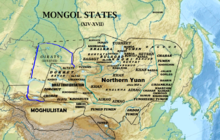Western Mongolia
 |
|
| Total population | |
|---|---|
| 638,372 | |
| Regions with significant populations | |
|
|
205,000 (2010 census) |
|
|
183,372 (2010 census) |
|
|
250,000 (2013 estimate) |
| Languages | |
| Oirat、other Mongolian | |
| Religion | |
| Tibetan Buddhism, Shamanism | |
| Related ethnic groups | |
| Mongols,Tuvans | |
Oirats (Mongolian: "ойрад", "ойрд", Oird; in the past, also Eleuths) are the westernmost group of the Mongols whose ancestral home is in the Altai region of western Mongolia. Although the Oirats originated in the eastern parts of Central Asia, the most prominent group today is located in Kalmykia, a federal subject of Russia, where they are called Kalmyks.
Historically, the Oirats were composed of four major tribes: Dzungar (Choros or Olots), Torghut, Dörbet, and Khoshut. The minor tribes include: Khoid, Bayads, Myangad, Zakhchin, Baatud.
The name probably means "oi" (forest) and "ard" (person), and they were counted among the "forest people" in the 13th century. A second opinion believes the name derives from Mongolian word "oirt" (or "oirkhon") meaning "close (as in distance)," as in "close/nearer ones."
The name Oirat may derive from a corruption of the group's original name Dörben Öörd, meaning "The Allied Four." Perhaps inspired by the designation Dörben Öörd, other Mongols at times used the term "Döchin Mongols" for themselves ("Döchin" meaning forty), but there was rarely as great a degree of unity among larger numbers of tribes as among the Oirats.
In the 17th century, Zaya Pandita, a Gelug monk of the Khoshut tribe, devised a new writing system called Todo Bichig (clear script) for use by the Oirat people. This system was developed on the basis of the older Mongolian script, but had a more developed system of diacritics to preclude misreading, and reflected some lexical and grammatical differences of the Oirat language from Mongolian.
...
Wikipedia
